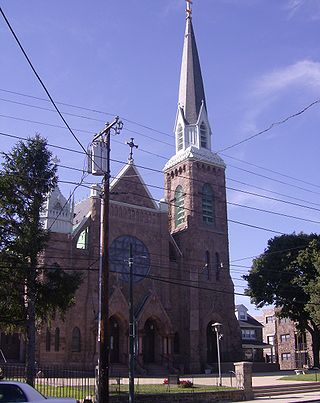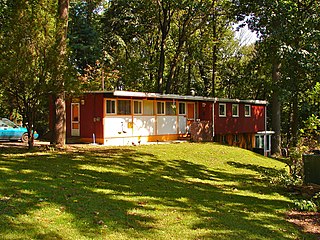
Frank Heyling Furness was an American architect of the Victorian era. He designed more than 600 buildings, most in the Philadelphia area, and is remembered for his diverse, muscular, often unordinarily scaled buildings, and for his influence on the Chicago architect Louis Sullivan. Furness also received a Medal of Honor for bravery during the Civil War.

Fox Chase is a neighborhood in Northeast Philadelphia, Pennsylvania, United States.

The Garden District is a neighborhood of the city of New Orleans, Louisiana, United States. A subdistrict of the Central City/Garden District Area, its boundaries as defined by the New Orleans City Planning Commission are: St. Charles Avenue to the north, 1st Street to the east, Magazine Street to the south, and Toledano Street to the west. The National Historic Landmark district extends a little farther.

Holmesburg began as a Village within Lower Dublin Township, Pennsylvania. It is now a neighborhood in the Northeast section of Philadelphia, Pennsylvania, United States. Holmesburg was named in Honor of Surveyor General of Pennsylvania Thomas Holme, who was a cartographer.

Hope Lodge is a historic building located at 553 South Bethlehem Pike in Fort Washington, Pennsylvania, in the United States. This mansion has been described as "one of the finest examples of Georgian Colonial architecture in this part of the country. It was used by Continental troops during the 1777 Philadelphia Campaign during the American Revolution.

Graeme Park is an historic site and National Historic Landmark at 859 County Line Road in Horsham, Montgomery County, Pennsylvania. It is owned by the Pennsylvania Historical and Museum Commission and operated by the non-profit group, The Friends of Graeme Park. It is the only surviving residence of a colonial-era Pennsylvania governor. Graeme Park was constructed in 1722 by Sir William Keith as a summer residence and alternative to his governor's mansion at Shippen House on Second and Spruce Streets in Philadelphia. The house, originally known as Fountain Low, has been largely unchanged since its construction except for a restoration by Dr. Thomas Graeme in the mid 18th century and a minor restoration by the Pennsylvania Historical and Museum Commission in the 1960s.

Andalusia, also known as the Nicholas Biddle Estate, is a historic mansion and estate located on the Delaware River, just northeast of Philadelphia, in Bensalem Township, Bucks County, Pennsylvania. The community surrounding it, Andalusia, takes its name from the 225-acre estate.

George Howe (1886–1955) was an American architect and educator, and an early convert to the International style. His personal residence, High Hollow (1914-1917), established the standard for house design in the Philadelphia region through the early 20th century. His partnership with William Lescaze yielded the design of Philadelphia's PSFS Building (1930–32), considered the first International style skyscraper built in the United States.

The Arch Street Meeting House, at 320 Arch Street at the corner of 4th Street in the Old City neighborhood of Philadelphia, Pennsylvania, is a Meeting House of the Religious Society of Friends (Quakers). Built to reflect Friends’ testimonies of simplicity and equality, this building is little changed after more than two centuries of continuous use.

The Asa Packer Mansion is a historic house museum on Packer Road in Jim Thorpe, Pennsylvania, United States. Completed in 1861, it was the home of Asa Packer (1805–1879), a coal and railroad magnate, philanthropist, and founder of Lehigh University. Asa Packer was also a major contributor in the Lehigh Valley Railroad system. The mansion is one of the best preserved Italianate Villa homes in the United States, with original Victorian furnishings and finishes. It was designated a National Historic Landmark in 1985.

The John Coltrane House is a historic house at 1511 North 33rd Street in Philadelphia, Pennsylvania, USA. A National Historic Landmark, it was the home of American saxophonist and jazz pioneer John Coltrane from 1952 until 1958. On his death in 1967 the house passed to his cousin, who sold it in 2004. Efforts for restoration and reuse as a jazz venue are struggling. In 2022, two of Coltrane's sons filed a lawsuit contesting the ownership of the home.

Lemon Hill is a Federal-style mansion in Fairmount Park, Philadelphia, built from 1799 to 1800 by Philadelphia merchant Henry Pratt. The house is named after the citrus fruits that Pratt cultivated on the property in the early 19th century.

The Masonic Temple is a historic Masonic building in Philadelphia. Located at 1 North Broad Street, directly across from Philadelphia City Hall, it serves as the headquarters of the Grand Lodge of Pennsylvania, Free and Accepted Masons. The Temple features the Masonic Library and Museum of Pennsylvania, and receives thousands of visitors every year to view the ornate structure, which includes seven lodge rooms, where today a number of Philadelphia lodges and the Grand Lodge conduct their meetings.

The Ebenezer Maxwell House, operated today as the Ebenezer Maxwell Mansion, is an historic house located in the West Germantown neighborhood of Philadelphia, Pennsylvania.

Greenbelt Knoll is a residential development in the Northeast section of Philadelphia, Pennsylvania. Planned and built from 1952 to 1957, it is notable as the first planned racially integrated development in Philadelphia and among the first in the United States.

The Adams County Courthouse is located in Gettysburg, Pennsylvania. It was added to the National Register of Historic Places on October 1, 1974.

The Lancaster County Courthouse is an historic, American courthouse building that is located in Lancaster, Lancaster County, Pennsylvania.

Richardson Brognard Okie Jr. (1875-1945) was an American architect. He is noted for his Colonial-Revival houses and his sensitive restorations of historic buildings.

Autun, also known as Meadowcourt, is a historic home located in West Whiteland Township, Chester County, Pennsylvania. Designed by the architect Edmund Beaman Gilchrist in 1928 and completed in 1929, it is a 1+1⁄2-story, French style, "L"-shaped country house.

























